The Name of the Early 20thcentury Movement That Was Concerned With Art of the Absurd
In the wake of World War One, Surrealism entered into the art world like a storm wreaking havoc on any preconceived ideas the people of Paris may accept had about the nature of reality, fine art, and the human mind. Drawing upon theories in psychoanalysis, this revolutionary art movement reached deep into the psyche. By provoking intense intellectual and emotional research in this mode, information technology inverse the confront of modern art.
Table of Contents
- 1 What Is Surrealism?
- ii The Birth of Surrealism Art
- 2.1 Surreal Influences
- 3 Surrealist Literature, Sculpture, and Picture palace
- 3.1 Literature
- three.ii Sculpture
- 3.3 Cinema
- 4 Notable Surrealist Artists
- 4.ane Salvador Dali (1904–1989)
- 4.2 Pablo Picasso (1881-1973)
- four.3 Joan Miró (1893-1983)
- 5 Surrealist Styles and Techniques
- 5.ane Automatism
- v.ii Frottage and Grattage
- 5.three Freeform
- 6 Surrealism Today
- 7 Frequently Asked Questions
- 7.i What Is the Main Idea of Surrealism?
- 7.2 How Is Surrealism Used Today?
- 7.iii What are the Characteristics of Surrealism?
- 7.four What Is an Example of Surrealism?
- vii.v What Are Some Techniques Used to Make Surrealism Art?
What Is Surrealism?
The word Surrealism refers to an art movement that entered the unsuspecting art earth in the mid-1920s. It was officially founded past André Breton, a Parisian poet. Surrealism became a formal fine art movement, with a strong political, philosophical and social undercurrent that defined the methods used to arm-twist daze and curiosity among its following. Its ground-breaking effort to cut through the pre-existing norms of the time spread to Europe and the U.s.a. in the 1920s and 1930s.
Surrealist fine art was an outcry against the rationality that its proponents saw as a dominating and destructive force in society, and indeed in the minds of people, that was responsible for much of the social ills of the time. Through movie theatre, art, and literature, Surrealist artists let their unconscious minds take center stage as they used a diverseness of techniques to map the clockwork of their dreams and innermost imaginings.
While Surrealism allowed a platform for the exploration of their unconscious minds, Surrealist artworks also encouraged viewers to explore and evaluate theirs, through distorted and bizarre imagery that was inspired not by logical, rational thinking, but rather the absurd events and images that emerged in the dream-state, or images that were derived simply from uninhibited free-form drawing or painting.
These shocking, illogical, and challenging compositions were not jump to the confines of the rules and social mores that were seen to govern art and society at the time, and which people might expect from art.
The Birth of Surrealism Art
The catamenia surrounding the world wars was fraught with scenes of violence and horror, and it was his own experience equally a nurse that inspired André Breton to write his offset few poems. In 1924, Breton published The Surrealist Manifesto, which summarized answers to the question "what is Surrealism?". The Manifesto covered the range of ideas that underpinned surrealism as a movement that was inextricably linked with psychoanalytic theories of the unconscious as a force that was behind all creative endeavors. His Surrealism art definition was every bit follows:
"Let us not lose sight of the fact that the idea of Surrealism aims quite only at the total recovery of our psychic force by a means which is nix other than the dizzying descent into ourselves, the systematic illumination of hidden places, and the progressive concealment of other places…"
The motility became notorious for being sectional and rejecting members because they were not seen to suit to the ideals put described in the manifesto. Breton drew upwards a revised version of the manifesto in 1930, to depict an updated version of his Surrealism art definition.
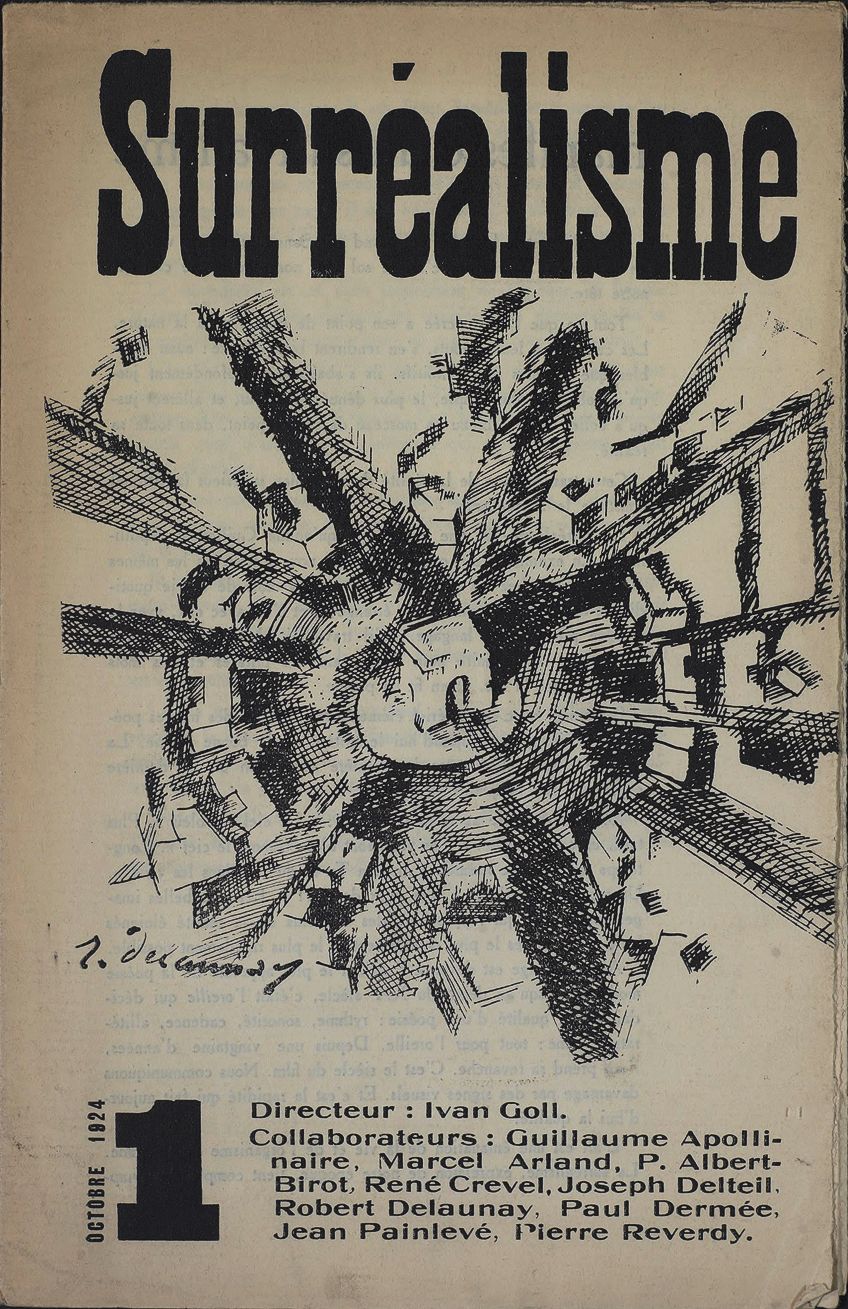 Robert Delaunay's analogy on the comprehend of Yvan Goll'southward Surréalisme, Manifeste du surréalisme,1924; Robert Delaunay, Public domain, via Wikimedia Commons
Robert Delaunay's analogy on the comprehend of Yvan Goll'southward Surréalisme, Manifeste du surréalisme,1924; Robert Delaunay, Public domain, via Wikimedia Commons
The motility was named subsequently Guillaume Apollinaire, an innovative poet, and fine art critic, who was the beginning to employ the word "surrealist" every bit a subtitle for one of his most scandalous plays. He was widely known as an art critic and fellow member of the Cubist art movement and was a source of groovy inspiration to the next generation of artists whose artwork embodied the characteristics of Surrealism.
The first Surrealist exhibition to have place was La Peinture Surréalist, which was held in Paris. It took place in 1925 in Paris and featured the works of Pablo Picasso, Man Ray, and Paul Klee (among many others).
Originating in Paris, the Surrealist art movement soon swept through Europe, claiming the imaginations of many artists at the fourth dimension. And, although Surrealism became notorious for banishing those who were found not to conform to the ethics that defined the motion, information technology shortly took hold of artists in the United states of america when many of the major Surrealist artists had no other choice but to flee Europe and to move, and showroom their art and philosophy, in the USA.
The contagious ideals of this movement that challenged the boulder of society spread like wildfire in the art world there. Surrealism also influenced artists in Due south America.
Surreal Influences
Surrealism art was different other art movements in the fashion that it took a step into deeper aspects of the human being feel, daring to delve into deeper realms untouched by other artists to summon to the low-cal hidden parts of the homo unconscious.
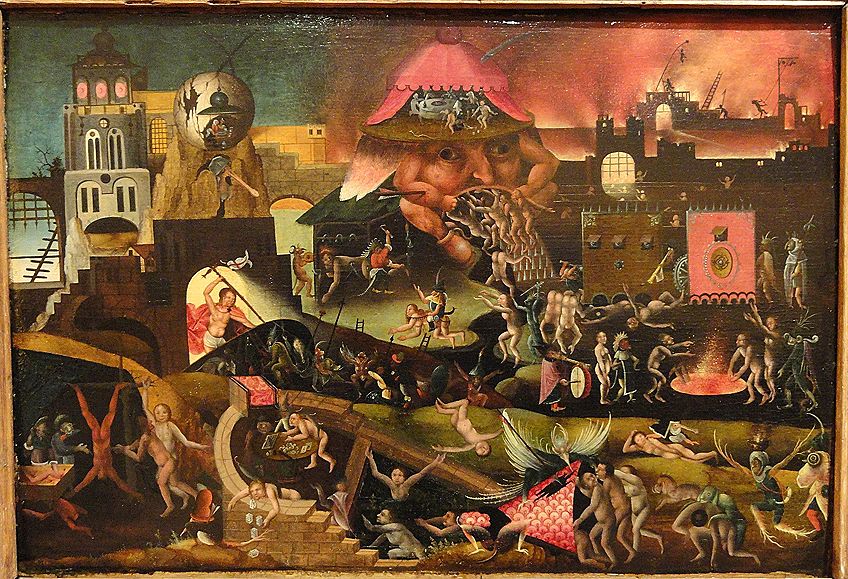 Christ in Limbo(1550) by a follower of Hieronymous Bosch;Follower of Hieronymus Bosch, Public domain, via Wikimedia Eatables
Christ in Limbo(1550) by a follower of Hieronymous Bosch;Follower of Hieronymus Bosch, Public domain, via Wikimedia Eatables
But it was also multi-faceted in the sense that it was not defined by a specific mode or combination of creative elements. Like most other artforms, Surrealism was influenced by other artists and other art movements. Specifically, it was influenced past, for example, the images brought to life by artists like Hieronymus Bosch and Francisco Goya. Other artists that inspired the Surrealist movement included Odilon Redon and Marc Chagall.
Dadaism
Surrealism inherited its tearing opposition to rationality from Dadaism, which was an art movement that shook early 20th century Europe and New York. The Dada movement was created in protestation to the war, and the social and cultural structures that were feature of the time.
Artists that identified with it used spontaneity, teamwork, and chance or luck to produce their work. Challenging traditional, rigid approaches to fine art, they focused mainly on creating collage and photomontage rather than the more traditional painting and sculpture to redefine the meaning of art.
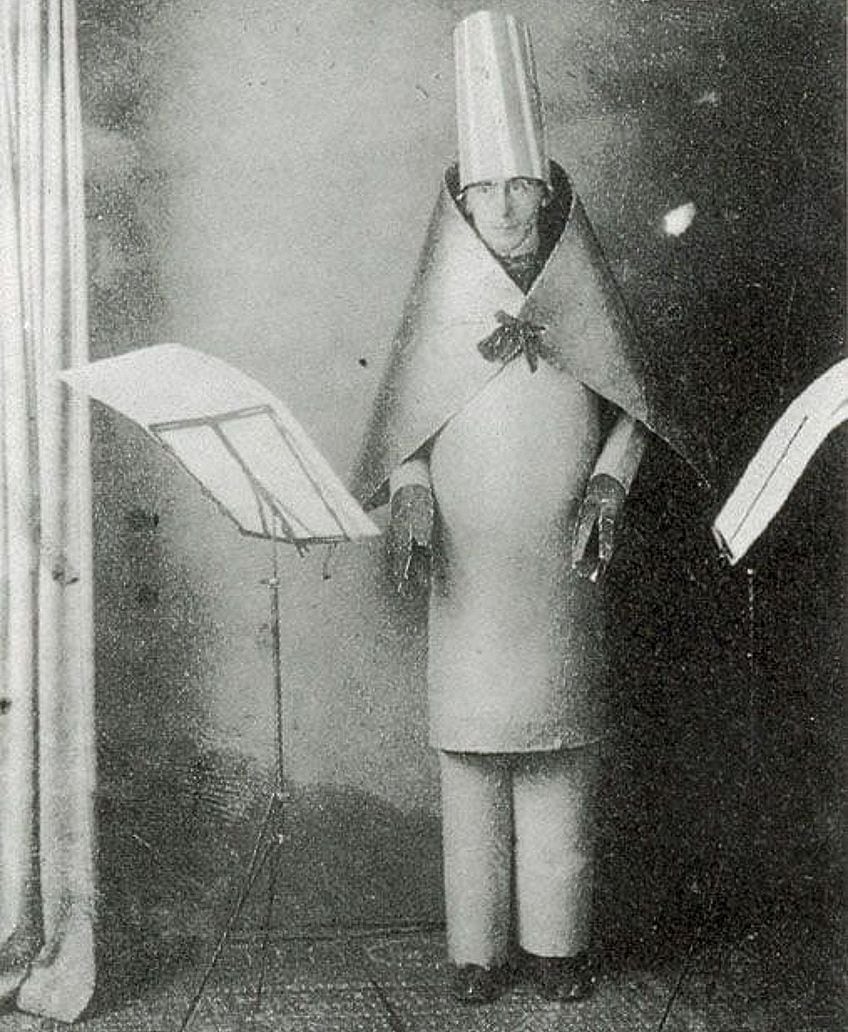 Cabaret Voltaire(1916) by Hugo Ball;Unknown author Unknown author, Public domain, via Wikimedia Commons
Cabaret Voltaire(1916) by Hugo Ball;Unknown author Unknown author, Public domain, via Wikimedia Commons
Although there was a definite socio-political season to Surrealist art, the heart of the move lay not in replicating other artworks or ideas, but in being a highly personal project that invited both the artists and the viewers to relinquish all conceptions of what fine art should be and turn inward. This cocky-reflection opened up space for what the Surrealists regarded every bit the ultimate reality to take course through the super-imposition of the conscious with the unconscious, resulting in a creative work that escapes the understanding of the rational listen.
This experimental entry into the deeper world of the subconscious found its origin in the psychoanalytic works of Freud and perhaps Jungian ideas besides. The role of dreams, therefore, played an inevitable part in defining some of the content that was included in several paintings.
The Bureau for Surrealist Research
In improver to the publication of The Surrealist Manifesto in 1924, this year also saw the formation of the Agency for Surrealist Research in Paris. This was a collection of artists and writers who were concerned with edifice a portfolio of information relating to how the unconscious heed reveals itself.
 Cover of La Revolution Surrealiste Mag, Volume 8,1926; Collective, Public domain, via Wikimedia Commons
Cover of La Revolution Surrealiste Mag, Volume 8,1926; Collective, Public domain, via Wikimedia Commons
This data was collected in two ways. Firstly, it was collected through recording dreams. Secondly, a record was kept of the beliefs and responses of the people who visited the office. In the same year, the periodical La Revolution Surrealiste started being published, which included the writings of Max Ernst and Human Ray.
Surrealist Literature, Sculpture, and Cinema
Although art is the most well-known expression of Surrealist ideas, these passionate philosophies, that brought taboo and repressed topics to the fore, had a potent presence in literature, sculpture, and movie house as well.
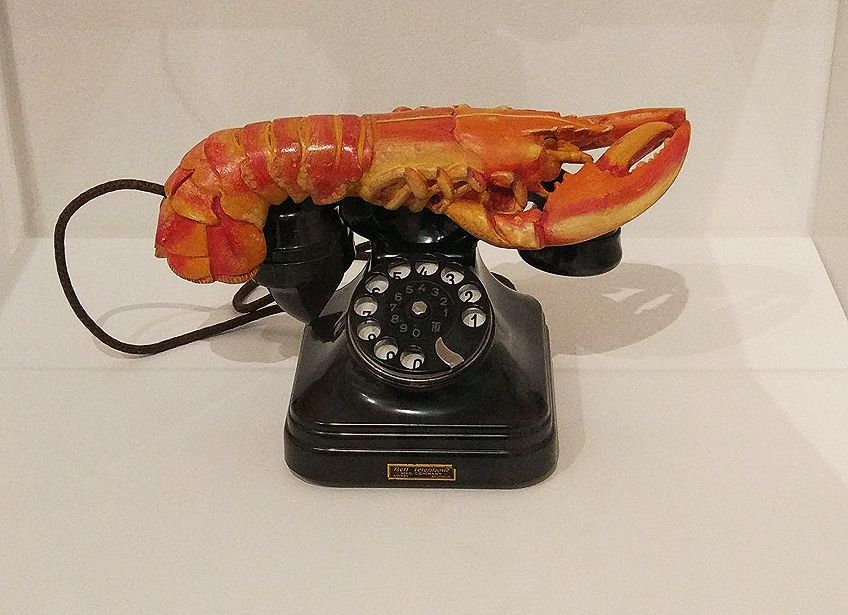 Lobster Telephone(1936) by Salvador Dali;Nasch92, CC By 4.0, via Wikimedia Eatables
Lobster Telephone(1936) by Salvador Dali;Nasch92, CC By 4.0, via Wikimedia Eatables
Literature
The get-go text, Les champs Magnetiques (The Magnetic Fields) that claimed the identity of beingness associated with "Surrealism", and which used the technique of automatic writing, was written by André Breton and Phillipe Soupault.
Notable Surrealist poets include André Breton, Paul Éluard, Louis Aragon, Pierre Reverdy, Michel Leiris, Antonin Artaud, René Crevel, and Robert Desnos. The words, through the poets, were the vessels or the conduit for the conscious expression of the unconscious.
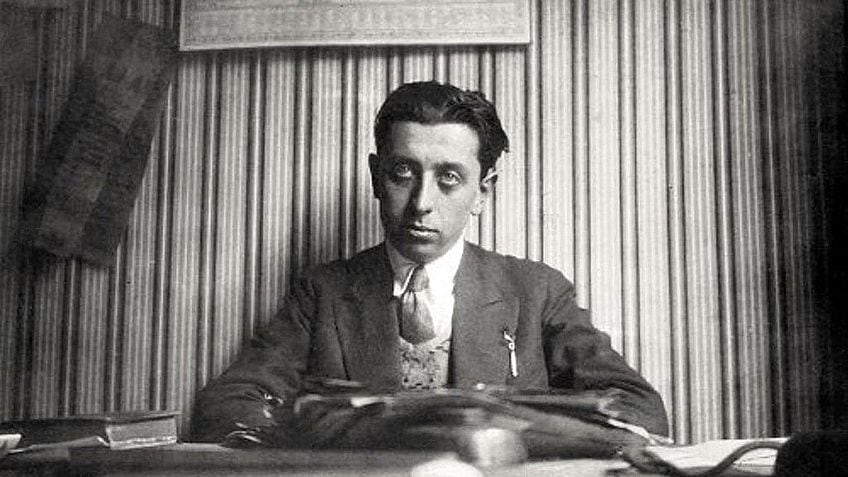 Photograph of Robert Desnos taken in 1924;Menerbes, CC Past-SA 3.0, via Wikimedia Eatables
Photograph of Robert Desnos taken in 1924;Menerbes, CC Past-SA 3.0, via Wikimedia Eatables
In addition to Surrealist verse, a number of journals were published between 1920 and 1940 every bit well, including La Révolution Surréaliste, Le Surréalisme au service de la révolution and a magazine chosen Minotaure.
Sculpture
Surrealism sculptures embodied the same principles as the other forms of Surrealism, only they introduced the chemical element of 3-dimensionality and touch to the idea of bringing the unconscious to life. This made the artwork more interactive and accessible to the viewer.
 Fountain(1917) by Marcel Duchamp;Marcel Duchamp, Public domain, via Wikimedia Commons
Fountain(1917) by Marcel Duchamp;Marcel Duchamp, Public domain, via Wikimedia Commons
Surrealism sculptures may not be as pop as the paintings, but they have had a lasting influence on creative art in the 21st century. Some of the most widely known sculptures include the work of Man Ray and Marcel Du Champ.
Movie theatre
Surrealist cinema is relatively unique when compared to other styles, in its expression of the unconscious, or dream-like land, not only through imagery and story but in the way that it is compiled in an illogical and often unpredictable fashion. Like Surrealist painting, Surrealist films share a few characteristics in common that relate not so much to content equally to the fashion the films are compiled to bring people out of their comfy cocoons of ignorance or inactivity.
Luis Buñuel is considered one of the fundamental figures in the establishment of Surrealist movie theater, which was aimed at stimulating thought and bringing out intense emotional responses, often achieved past playing on people's fears. The Seashell and the Clergyman (1928) is widely held to exist the first official Surrealist picture show. It was the collaborative encephalon-child of by Germain Dulac and Antonin Artaud.
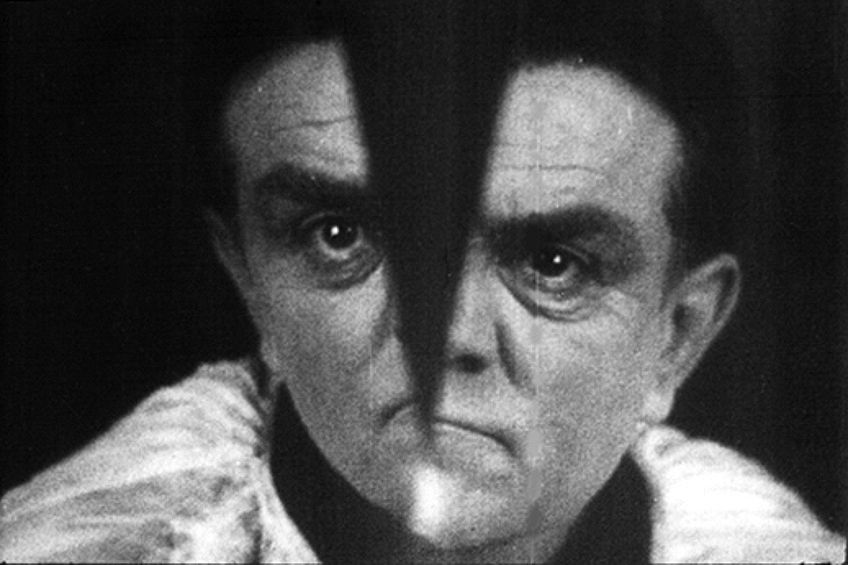 Frame from the movieThe Seashell and the Clergyman (1928) past Germaine Dulac; Germaine Dulac (1882-1942), Public domain, via Wikimedia Commons
Frame from the movieThe Seashell and the Clergyman (1928) past Germaine Dulac; Germaine Dulac (1882-1942), Public domain, via Wikimedia Commons
Surrealist films contain a considerable dose of shock-value, accomplished possibly by bombarding the audition with shocking imagery that may or may not resemble dreams and nightmares, and with the presentation of objects in contexts, one wouldn't normally associate them with. Add to this, characters who seemingly lack a moral compass and a plot that does not accept a chronological flow, and you have a classically Surrealist moving-picture show.
Notable Surrealist Artists
In its hey-solar day, the tenets of Surrealism were represented past many artists from all across the world. Although Surrealism started in Paris, the membership of the Surrealist fine art motion reflected the cosmopolitanism of Europe itself. Many of the towering figures that diameter the Surrealist flag with integrity and flourish were from diverse cultures, including Kingdom of spain, Germany, and Holland, not to mention New York.
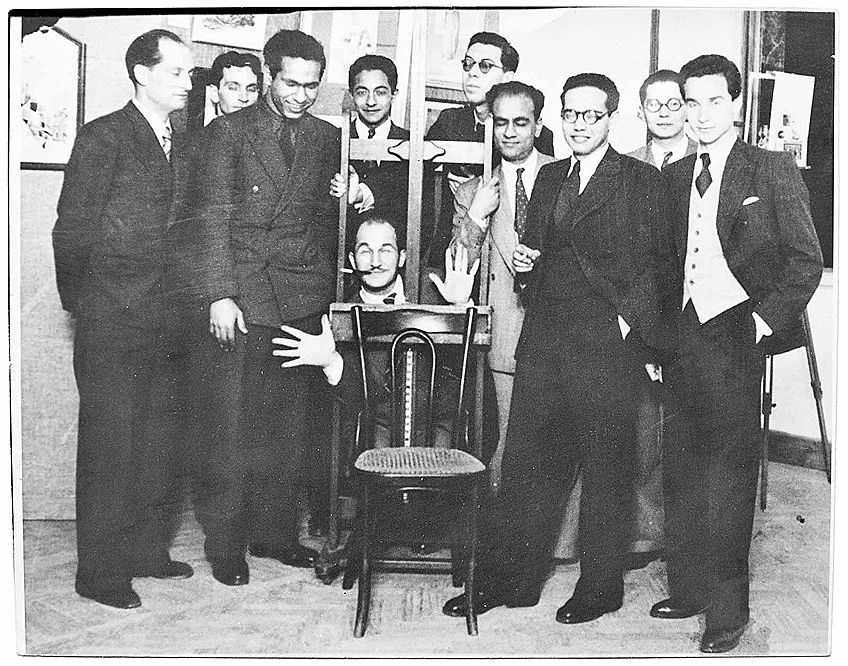 Photograph of the Members of the Fine art et Liberté Group, an Egyptian Surrealist group. Front row, left to correct: Jean Moscatelli, Kamel el Telmissany, Angelo de Riz, Ramses Younan, Fouad Kamel. Dorsum row, left to right: Albert Cossery, unidentified, Georges Henein, Maurice Fahmy, Raoul Curiel (1941);The Younan Family Annal, Public domain, via Wikimedia Commons
Photograph of the Members of the Fine art et Liberté Group, an Egyptian Surrealist group. Front row, left to correct: Jean Moscatelli, Kamel el Telmissany, Angelo de Riz, Ramses Younan, Fouad Kamel. Dorsum row, left to right: Albert Cossery, unidentified, Georges Henein, Maurice Fahmy, Raoul Curiel (1941);The Younan Family Annal, Public domain, via Wikimedia Commons
The movement captured the spirit of the tumultuous time subsequently the state of war, and the feelings in the aftermath transcended international boundaries. Some of the more than famous works that take stood the test of time include those of Salvador Dali, Pablo Picasso, Jean Arp, Yves Tanguy, Man Ray, Andre Masson, Leonora Carrington, and Rene Magritte.
Salvador Dali (1904–1989)
Assimilating several creative styles in art school, Spain-born Salvador Dali's piece of work flew to new heights once he started exploring the works of Freud, and when he started associating himself with the Surrealist movement. These influences are clearly evident in his early work.
However, later on in his career, his political views started to deviate from those of the Surrealist motility, and, for this reason, he was told to leave. His work started to take on a unlike season, drawing inspiration from artists such every bit Raphael, the Renaissance creative person. The creative blood ran thick through Dali, and he continued to bring his artistic flair to other endeavors like interior decorating for loftier-end stores and designing jewelry.
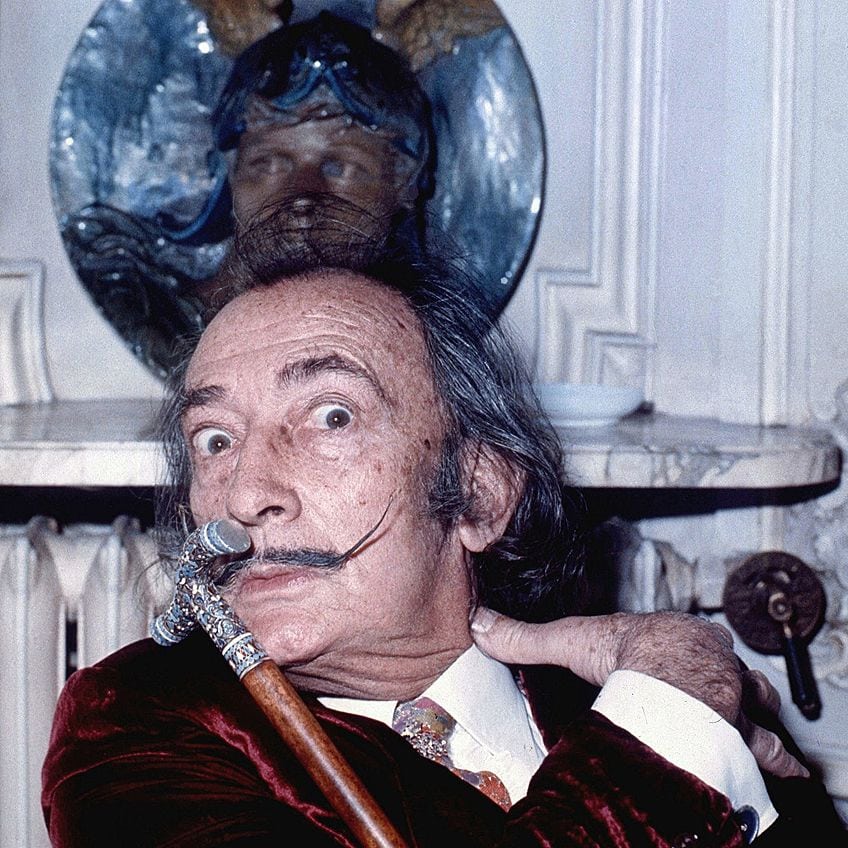 Portrait of Salvador Dali, taken in Hôtel Meurice, Paris (1972) by Allan Warren;Allan warren, CC Past-SA 3.0, via Wikimedia Commons
Portrait of Salvador Dali, taken in Hôtel Meurice, Paris (1972) by Allan Warren;Allan warren, CC Past-SA 3.0, via Wikimedia Commons
1 of the methods that Dali used to pause the shackles of his mind, was to induce a hypnotic state through what he called the "paranoiac-critical method". This involved him intentionally making himself paranoid, making irrational associations betwixt things that weren't related, to reach a delusional state that provided the ground for the images that he included in his art. The legend of Dali is still alive in modernistic culture not only because of his art and method. He had a manner of embodying the absurd, of bringing his creativity to life through life itself.
Persistence of Memory (1931)
Dali was and nevertheless is, known for his wide range of surreal paintings. 1 of the nigh famous works that have him etched in the annals of time every bit ane of the predominant figures in the Surrealist movement is The Persistence of Memory. Despite its enormous presence in the history of fine art and modern civilisation, the painting is humble in size – slightly larger than a piece of paper and is exhibited at the Museum of Modernistic Art in New York City. Dali brought this painting to life at the tender age of 28.
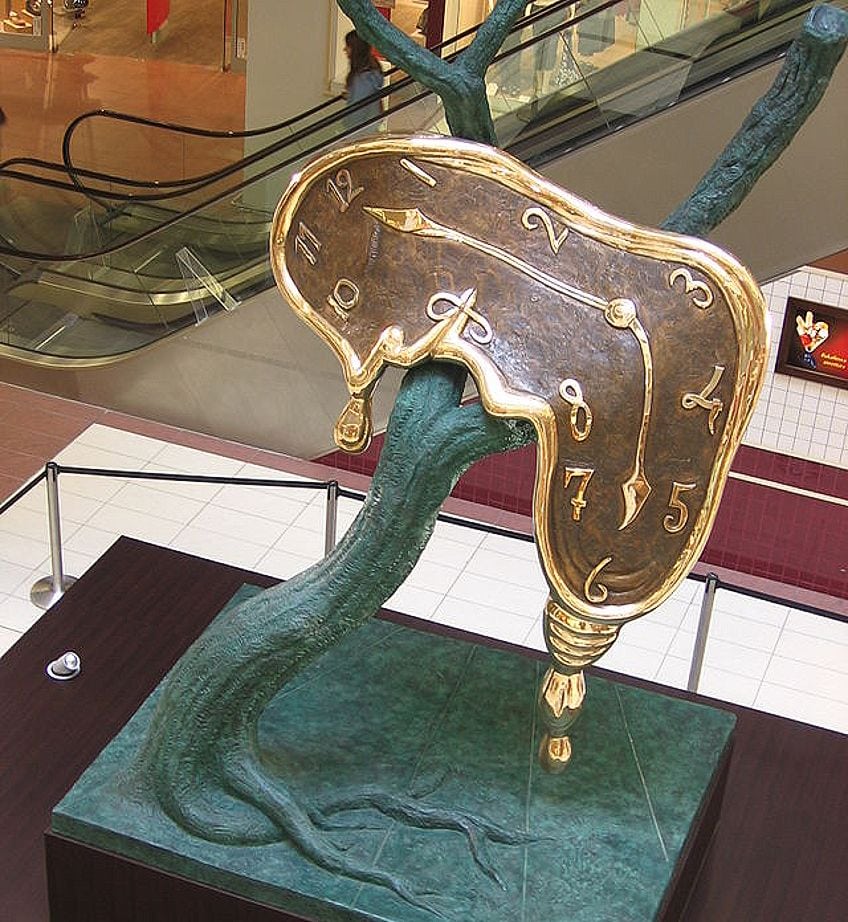 Profile of Time(1984) past Salvador Dali; Julo, Public domain, via Wikimedia Eatables
Profile of Time(1984) past Salvador Dali; Julo, Public domain, via Wikimedia Eatables
The Persistence of Memory is presented as a deserted landscape, interrupted simply by melting clocks that are draped over a dead tree. In that location is likewise a shape-less mankind-colored object near the middle of the painting (which Dali claimed to be a representation of himself), upon which another clock is unceremoniously draped. This landscape has been identified as Dali's hometown, Catalonia.
Pablo Picasso (1881-1973)
Pablo Picasso is another artist whose legend remains with u.s.a. today. The son of an art professor in Spain, Picasso grew up under the fly of his begetter. Early on in his career, however, he deviated from the traditional fine art forms that he had come to know every bit a kid.
Although Picasso is more frequently associated with Cubism (being one of the founders of this movement), his later work was influenced by Surrealism in a big way. Never quite an official fellow member of the movement, he was strongly continued with many of the major proponents of the movement, including Breton himself. His art embodied some of the Surrealist ideologies that fabricated the Surrealist movement what information technology was.
 Photo of Pablo Picasso taken in 1962; Argentina. Revista Vea y Lea, Public domain, via Wikimedia Eatables
Photo of Pablo Picasso taken in 1962; Argentina. Revista Vea y Lea, Public domain, via Wikimedia Eatables
He spent a period of his life moving betwixt France and Spain. Eventually, though, the colorful bourgeois life of Paris took hold of his imagination after he was swept off his anxiety by the passion and romance of the intellectual and artistic flair that characterized the Parisian temper in early on the early 20th century. He found himself unable to resist the temptation of finding passage to stay in France on a more permanent footing.
Although all-time known for the distorted imagery he brought to life through his painting, Picasso channeled his inventiveness into sculpting, ceramics, and poetry likewise. Past the end of his lifetime, he had conjured into being more than 20,000 pieces of fine art, including prints, ceramics, and costumes.
Picasso'southward painting changed in style considerably over his lifetime. Some of the paintings took on the distorted, almost dreamlike quality of surrealist artists. At other times, though, his mode of painting took on the awkward juxtaposition of various geometric shapes to make up everyday objects, figures, and portraits.
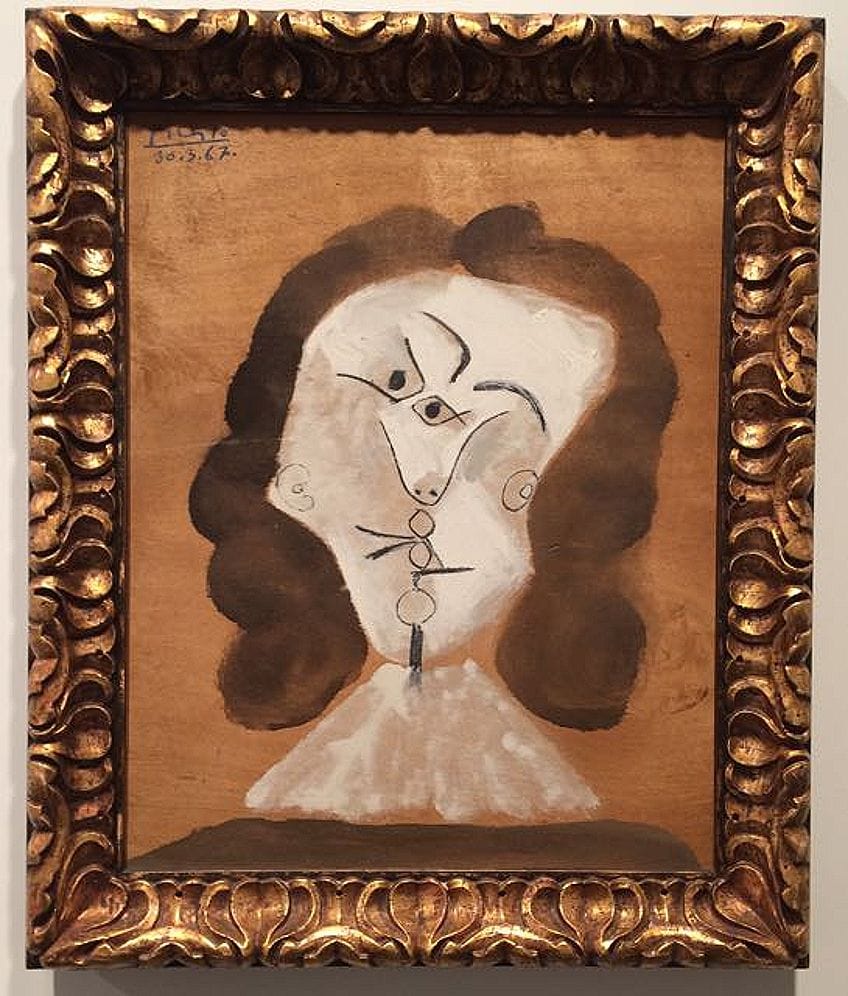 Mousquetaire, Tête(1967) by Pablo Picasso;Mika58, CC By-SA four.0, via Wikimedia Commons
Mousquetaire, Tête(1967) by Pablo Picasso;Mika58, CC By-SA four.0, via Wikimedia Commons
Picasso's piece of work was, to some extent, defined by the colors he was using during different periods in his life. Some of the early paintings he created in Spain, for case, have been grouped into a category called "the Blue Menstruation", equally they comprised by and large blues. Upon arriving in France, he took on a more than rose-colored tone to his work. Hence, some of his paintings that emerged from the honeymoon phase of his life in France belong to the "Rose Menses" of his paintings.
Although not all of his paintings were political, nor conformed to the Surrealist ideals, Picasso summarizes his opinion of the significant of creative life: "Painting is not made to decorate apartments. Information technology is an offensive and defensive weapon against the enemy."
The Ruby-red Armchair (1931)
Picasso had intimate relationships with dissimilar women throughout his life, each inspired him. Indeed, changes in his painting mode tin exist seen to correspond with the entry of a new feminine muse into his life.
One of his famous Surrealist paintings, The Red Armchair is a portrait of Marie-Thérèse Walter, a wife who was 28 years older than Picasso. It shows a woman sitting on a chair with a frontal and side view of her face.
This dual perspective is sometimes interpreted as an acquittance of their secret matter. This painting was 1 of many portraits of Walter that were created for an exhibition at Galeries Georges Petit.
In this painting, Picasso uses industrial house pigment (Ripolin) in artistic and expert ways. He was addicted of this medium because of the solid end it gave by pouring it straight onto canvass, and because of its bright colors. In this painting, he mixed the paint with oil to produce interesting effects.
Joan Miró (1893-1983)
Breton described him as one of the all-time examples of a Surrealist artist. Today, he is considered to exist an abstruse creative person with distinctly Surrealist qualities. Unlike Picasso, Miró did not abound up nether the artistic influence of his parents who insisted that he go to commercial college; his father was a watchmaker and goldsmith.
Miró had a breakdown after having worked as a clerk for two years. At this point, he started studying art and had a teacher who sympathized with his need for engaging concretely with the subjects he was painting.
Early in his artistic career, Miró focused on painting landscapes, portraits, and nudes and was influenced largely by Fauvism and Cubism at that time, but the content of what he painted and the philosophy that underpinned his artistic creations had strong similarities with Dadaism and Surrealism. It was mainly betwixt 1925 and 1928 that his artwork started to metamorphize into truthful Surrealist paintings in the way that they depicted imaginary scenes that resembled the dream-world. He signed The Surrealist Manifesto in 1924.
Like the other artists, he was also struck past the cultural upsurge in Paris and for many years he, similar Dali, traveled between his country of origin and France. Like many other artists of the age, he felt moved past the atrocities of the state of war also every bit the socio-political climate of the fourth dimension and used art to communicate his political views and mood.
At a later stage, he started working with José Llorens in the pottery globe, making artistic choices that challenged people's expectations of the art form, in a very Surrealist way.
Dog Barking at the Moon (1926)
The Domestic dog Barking at the Moon is one of Miró'southward most well-known paintings. Information technology came into being while he was living in Spain. This painting depicts an animal that vaguely resembles a canis familiaris, with a ladder on the left stretching into the night sky. The moon is on the far right of the moving picture, painted with a blood-red olfactory organ and a eye. It is set against a nighttime heaven on an eerie surface that, to no minor degree, reflects the alien landscape of Catalonia, where the artist grew up. The Surrealist qualities are no mystery in this painting, and it has a humorous quality to it that became characteristic of Miro's later work.
Surrealist Styles and Techniques
Surreal paintings were defined not and then much by recognizable characteristics than by the philosophy that inspired the use of certain techniques to convey the intention of the artwork and allow information technology to achieve its aims. Some of the Surrealist piece of work of Picasso, for example, is different in style to that of Max Ernst. Artists changed their styles over time and even tended to utilize different styles and techniques in a single artwork.
 Les Voix Intérieures('Inner Voices', 1985) by Didier Mazuru;Didier Mazuru, CC BY-SA four.0, via Wikimedia Commons
Les Voix Intérieures('Inner Voices', 1985) by Didier Mazuru;Didier Mazuru, CC BY-SA four.0, via Wikimedia Commons
Some of the techniques used include automatism, collage, frottage, and grattage. To rescue the "object" from its unfortunate fate of existence victim to interpretation in terms of over-familiar contexts, Breton refers to "estrangement" as the process of removing objects from the normal circumstances in which we await to see them and placing them in an entirely new i. This allows viewers the opportunity to develop a new understanding of that object that is not influenced by culture.
Automatism
I of the defining features of the relentless mission of Surrealism to challenge people to peer into their subconscious is referred to every bit "automatism". This exercise allowed for creativity to emerge unfiltered by the rational listen and rules that governed traditional artistic pursuit. Automatism is often used in writing, where the author allows a stream of words to flow uninhibited, and the same process was applied to Surrealist painting.
 Automated writing demonstrated past the sorcerer William Marriott in 1910;William Marriott, Public domain, via Wikimedia Commons
Automated writing demonstrated past the sorcerer William Marriott in 1910;William Marriott, Public domain, via Wikimedia Commons
Frottage and Grattage
Surrealism is defined more by the underlying philosophy that informs the content that is portrayed, rather than being limited to a certain medium or style. However, some techniques were developed which many artists felt helped to make the artworks entice the viewer into thinking more laterally.
 Passage Noir('Black Passage', 1923) by Max Ernst; Pedro Ribeiro Simões from Lisboa, Portugal, CC Past 2.0, via Wikimedia Commons
Passage Noir('Black Passage', 1923) by Max Ernst; Pedro Ribeiro Simões from Lisboa, Portugal, CC Past 2.0, via Wikimedia Commons
These methods were idea to help viewers to explore the recesses of their subconscious mind past allowing them to witness the negative spaces left by techniques similar frottage and grattage. Frottage is when the artist creates a textured surface and lightly rubs information technology with a soft material such as a crayon. Grattage refers to when pieces of paint are removed in some mode.
Freeform
Surrealism fix the bar for a new type of fine art that did not arrange to whatever particular way and was rather defined by its philosophy, ideals, and content. The emphasis on the role of the unconscious in creating fine art, and the blatant anti-rationalism of the movement translated into freeform artistic expression on the canvas. This was in stark contrast to the rigid, highly structured Cubism that was besides making waves in the art scene in the early on to mid-twentieth century.
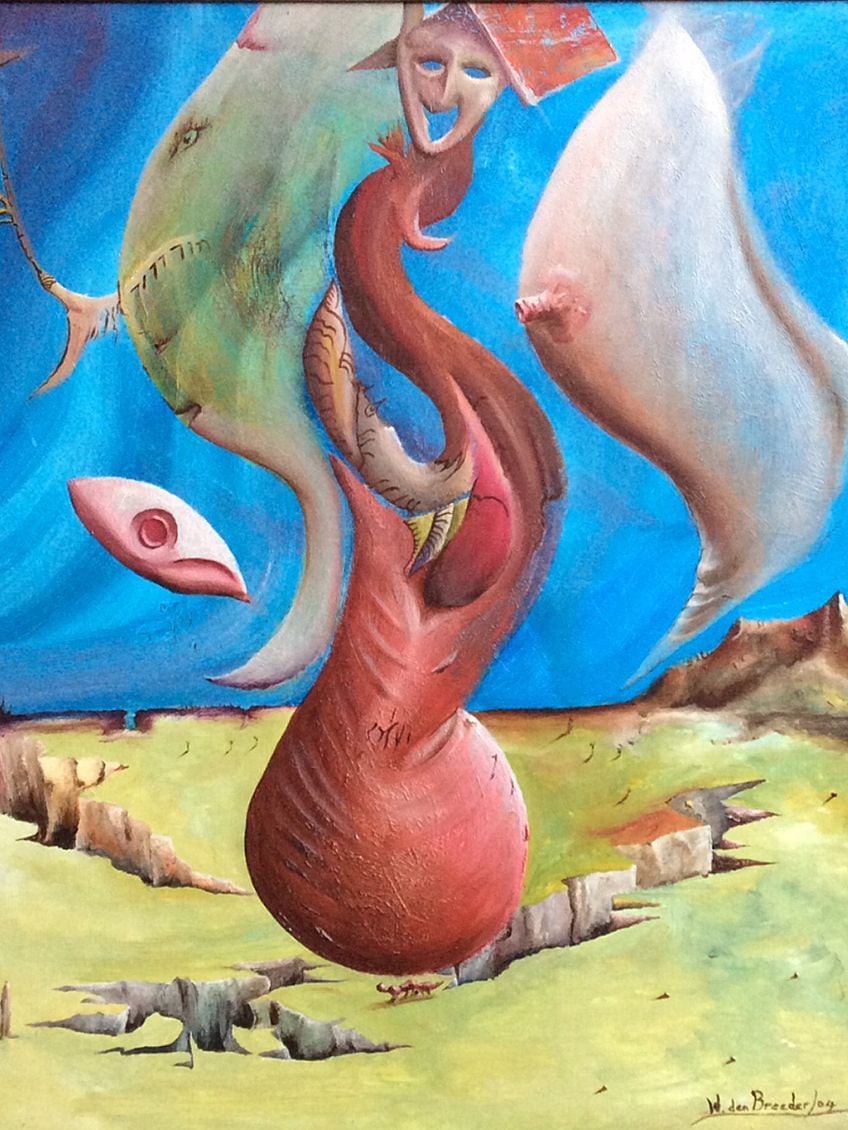 Allereerste Gedachten('Start Thoughts', 2004) by Willem den Broeder;Willem den Broeder, CC Past-SA 4.0, via Wikimedia Eatables
Allereerste Gedachten('Start Thoughts', 2004) by Willem den Broeder;Willem den Broeder, CC Past-SA 4.0, via Wikimedia Eatables
Surrealism Today
The influence of the thought-provoking and sometimes agonizing images that did emerge from the Surrealist artists' minds continues to capture the attention, prod the marvel and stimulate the minds of audiences even today. Decades after the motility, it continues to influence the art world. Absurdism, for case, remains strongly inspired past information technology. The works of Michael Cheval, for example, which grew in popularity in the new millennium, are testimony to the echoes that Surrealism has left in more than mod artistic minds. Some of the work of Anatole Krasnyansky, an American-Ukrainian water-colour artist, also embody the Surrealist content and mode.
Surrealism was unlike whatsoever art motion that had gone before. Equally a direct response to the atrocities of war, it challenged the socio-political status quo that was held to exist responsible for the social problems of the fourth dimension. Drawing from theories of the unconscious, its depth was oceanic and transcended the boundaries of infinite and time. Bold and innovative in its political statements, it shook the art world for decades to come up.
Accept a look at our Surrealism webstory here!
Frequently Asked Questions
What Is the Main Idea of Surrealism?
The Surrealist fine art movement challenged the rationality that was seen to govern early 20th-century French society. It was based on the idea that true reality, and creativity, came from the unconscious and that, through the exploration of the unconscious, a superior form of reality could be experienced.
How Is Surrealism Used Today?
Surrealism has afflicted the fine art (peculiarly in absurdism) every bit well as the literary and academic world. The famous works of prominent Surrealist figures go on to provide an avenue for the expression of taboo subjects, feelings, and ideas through two-D and 3-D art, style, picture palace, and literature.
What are the Characteristics of Surrealism?
Existence an abstract art that is not bars to a specific style, Surrealist art can accept many forms. You may identify it by the use of distorted images, dreamscapes, symbolism, and the bizarre representation and combination of ordinary objects. It is known for being absurd and provoking a range of responses.
What Is an Example of Surrealism?
During the early 1920s, several well-known artists belonged to the Surrealist Movement. These included Salvador Dali and Pablo Picasso. One of the most famous pieces is The Persistence of Memory by Salvador Dali.
What Are Some Techniques Used to Make Surrealism Fine art?
Automatism is a popularly used technique that allows the artist to express their unconscious, without their art being divers by the rational mind. Surrealism involves uninhibited artistic expression. Frottage and Grattage are also commonly used, which allows the viewer to see negative spaces and thereby promotes lateral thinking and the exploration of their minds. Frottage is when color is rubbed lightly over a textured surface. Grattage refers to the removal of paint later it has been applied.
feganwhistless1947.blogspot.com
Source: https://artincontext.org/surrealism-art/
0 Response to "The Name of the Early 20thcentury Movement That Was Concerned With Art of the Absurd"
Postar um comentário